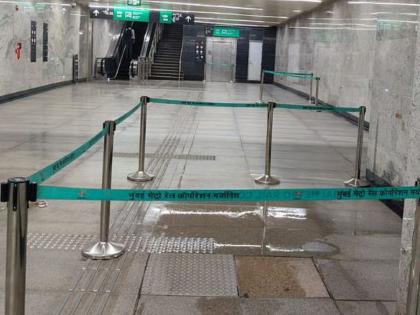Mumbai Metro Line 3: Leaks and Damp Walls Raise Safety Concerns At BKC Aqualine Station (See Post)
By Lokmat English Desk | Updated: June 19, 2025 13:27 IST2025-06-19T13:25:02+5:302025-06-19T13:27:13+5:30
Fresh concerns have emerged over the construction quality of Mumbai’s Metro Line 3 (Aqua Line) as water leakage issues ...

Mumbai Metro Line 3: Leaks and Damp Walls Raise Safety Concerns At BKC Aqualine Station (See Post)
Fresh concerns have emerged over the construction quality of Mumbai’s Metro Line 3 (Aqua Line) as water leakage issues have now surfaced at the Bandra Kurla Complex (BKC) and Worli metro stations—just days after rainwater entered the Acharya Atre station, causing reported damage. At Worli, water is leaking from the ceiling in at least four locations. Previously, the Mumbai Metro Rail Corporation (MMRC) faced criticism for placing buckets under leaking areas. Now, staff have been deployed to mop up the water continuously. At BKC station, leaking zones were recently cordoned off with ropes. Raising the issue MP Varsha Gaikwad took it to her official X account posting pictures and videos of the leakage found at the newly opened BKC Metro station which falls under the new Aqua line.
The Aqua Line of Mumbai Metro lives up to its name even when it is not raining! This is the BKC Metro station today. The roof is leaking constantly, so much so, that a small area has been cordoned off. Sometime ago we saw the utter devastation of the Acharya Atre Chowk and water… pic.twitter.com/Zjm62zPpPH
— Prof. Varsha Eknath Gaikwad (@VarshaEGaikwad) June 17, 2025
In the recent X post she stated, "The Aqua Line of Mumbai Metro lives up to its name even when it is not raining! This is the BKC Metro station today. The roof is leaking constantly, so much so, that a small area has been cordoned off. Sometime ago we saw the utter devastation of the Acharya Atre Chowk and water logging at several stations too. We also saw station exits being covered with tarpaulin sheets. But the question remains has any action been taken against the officials and contractors responsible for this shoddy work? This Triple Engine Corrupt sarkar is playing with people's lives and looting Maharashtra with impunity. Shame!"
MP Varsha Gaikwad has now stated that there was a significant leak from the BKC Metro Station's roof on Tuesday. The MMRC closed the area affected by the significant leak. Varsha Gaikwad shared a post on social media about this leak and has condemned the MMRC and the state administration. He has also called for measures against corrupt officials and contractors, claiming that the work is of poor quality. He has likewise charged the government with jeopardizing the lives of its citizens. In a previous incident, MMRC had resorted to covering station entrances with tarpaulin at the Acharya Atre station to prevent water ingress. Now, ongoing roof leaks at BKC are drawing increasing public scrutiny.
Passengers and media have reportedly been told not to photograph the leaks. Station staff have asked people to delete images and have placed signage prohibiting filming inside metro premises. During earlier leak incidents, media access to affected areas was similarly restricted. In response, MMRC said this monsoon is effectively the first full-scale operational test of the newly opened line. They acknowledged minor issues but claimed that these are being addressed, with repair orders issued to contractors. “Water dripping at isolated spots doesn’t necessarily indicate poor construction,” MMRC stated. “Some stations feature open areas, air vents, and ducts for ventilation and air conditioning, where heavy rain and wind can push water inside. Such leaks have been observed only at a few locations across the 22-kilometer stretch.”They also cited high humidity as a possible cause for water droplets forming due to condensation, especially around air-conditioned areas. MMRC emphasized that these are not cases of waterlogging or flooding. Despite reassurances, public dissatisfaction over the project's execution continues to grow, especially considering the project’s scale, budget, and critical role in easing Mumbai’s traffic and transit burden.